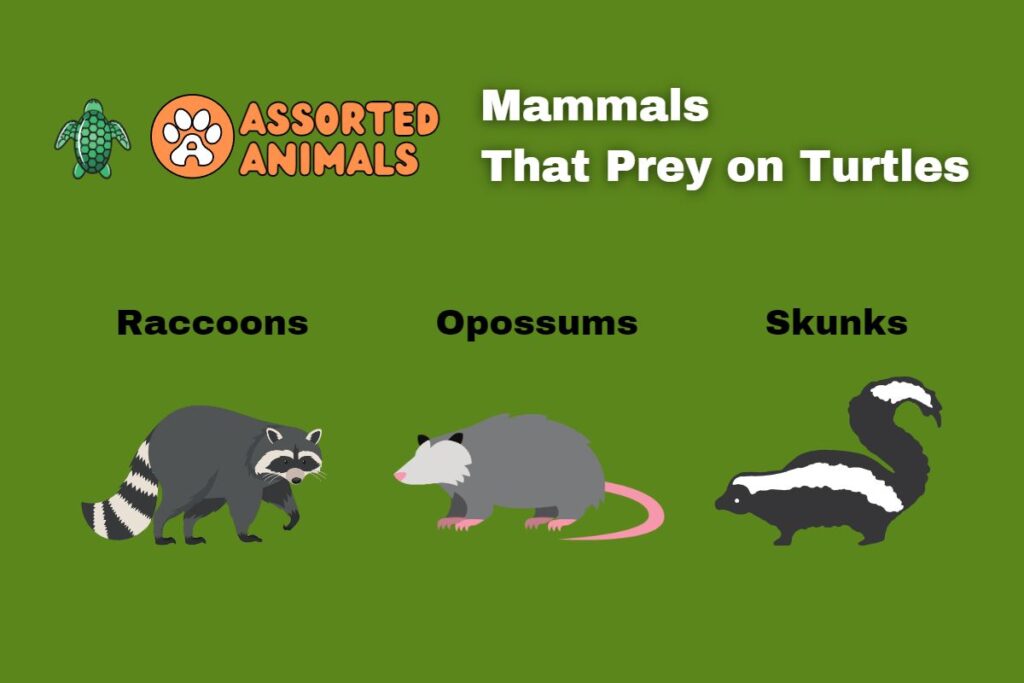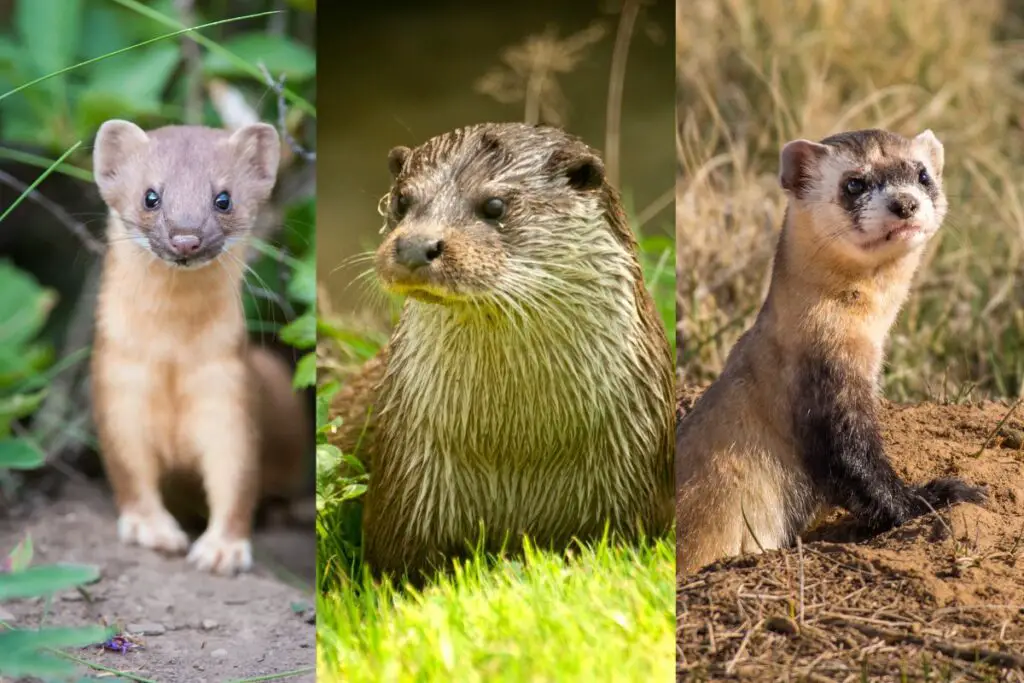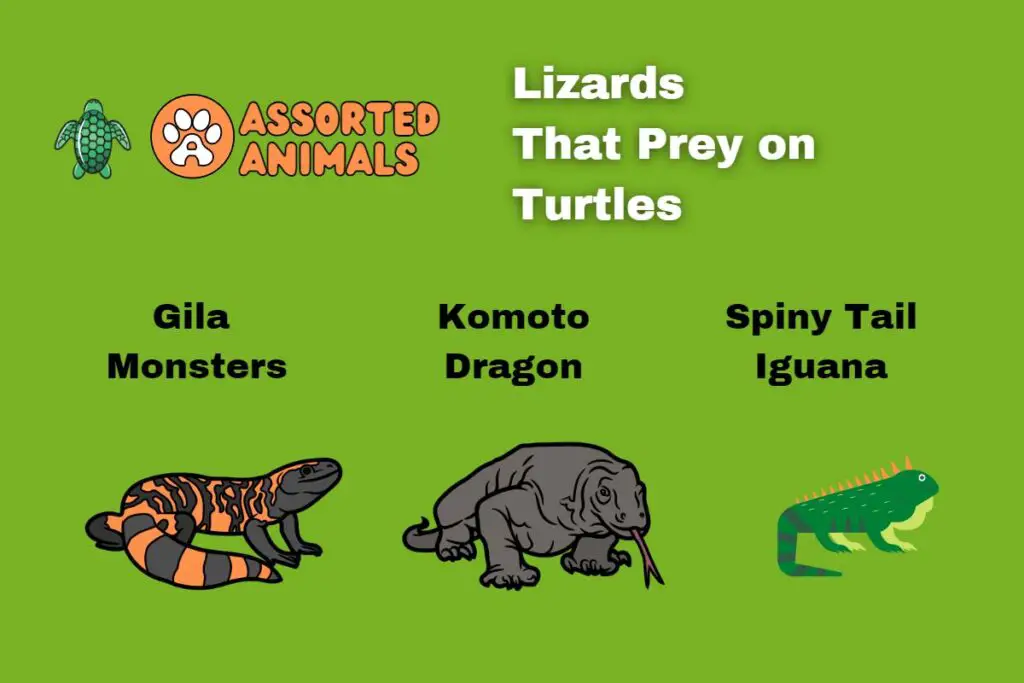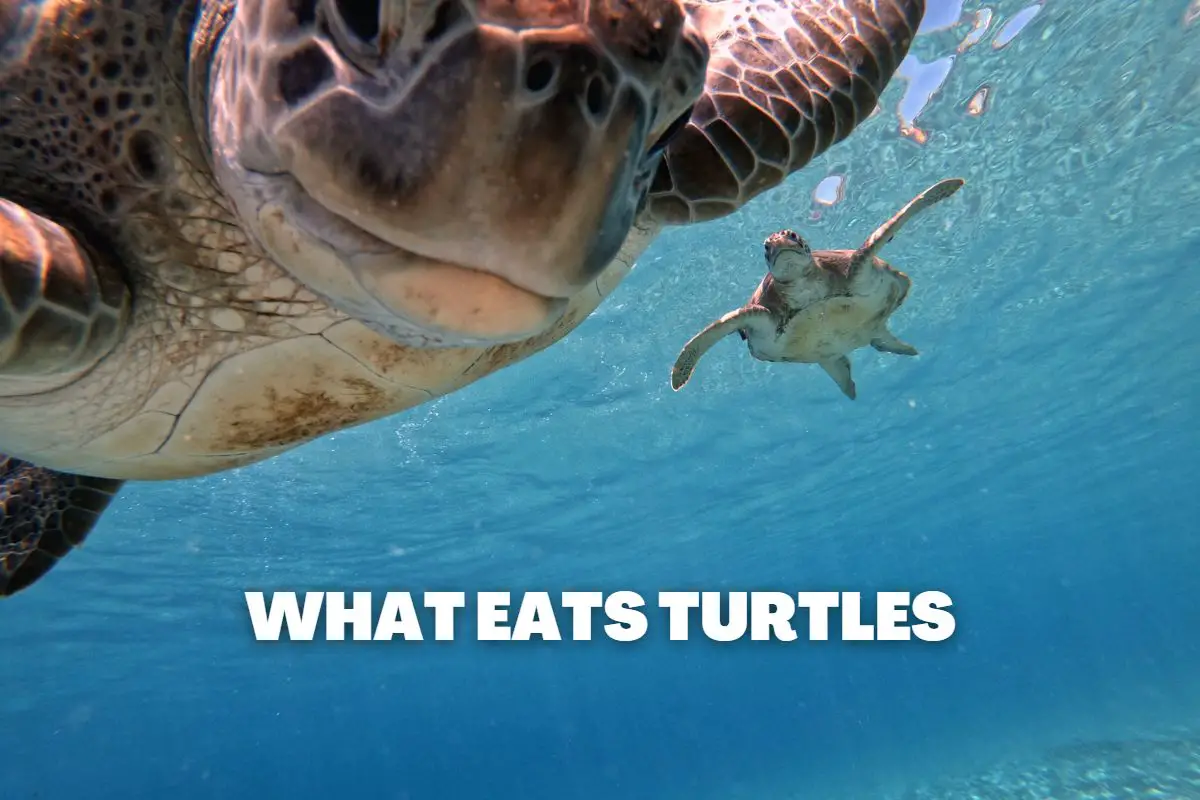Turtles can be both aquatic and terrestrial and they have many predators that eat them, from sharks in the water to coyotes on land! Heck, even humans eat turtles!
As a turtle enthusiast, I’ve always been fascinated by the various predators these reptiles face. It’s also pertinent to mention how turtles have adapted their abilities to defend themselves over time.
What Eats Turtles: Turtle Predators
Turtles, turtle eggs, and hatchlings are eaten by fish such as sharks and barracuda. On land, turtles are preyed on by mammals like raccoons and opossums, wild canids, and humans, as well as alligators, lizards, birds, and snakes. Turtles such as snapping turtles also eat other turtles.
Let’s take a closer look at some of the most common predators of turtles and how these turtles defend themselves against attack. So without further ado, let’s dive into the world of turtle predators!
Quick List of turtle predators, their regions, and the types of turtles that get preyed on:
| Predators | Region | Type of Turtle |
| Alligators | United States (southeastern states) | Various species of freshwater turtles |
| Crocodiles | Tropical regions worldwide | Various species of freshwater and marine turtles |
| Hawks | Worldwide | Various species of terrestrial and aquatic turtles |
| Owls | Worldwide | Various species of terrestrial and aquatic turtles |
| Snakes | Worldwide | Various species of terrestrial and aquatic turtles |
| Foxes | Worldwide | Various species of terrestrial turtles |
| Coyotes | United States (western states) | Various species of terrestrial turtles |
| Raccoons | United States (eastern and southern states) | Various species of terrestrial and aquatic turtles |
| Rats | Worldwide | Various species of terrestrial and aquatic turtles |
| Opossums | United States (eastern and southern states) | Various species of terrestrial and aquatic turtles |

What Animals Eat Baby Turtles?
Baby turtles, turtle hatchlings, turtle eggs, and nests, are all in constant threat of predation. Large hard shell turtles and tortoises do not have a lot of predators because their turtle shells are hard to crack, creating a perfect defense mechanism.
Sea turtles make their nests, lay their eggs, and then return to the sea. The eggs go 60 days in the nest before they start to hatch. After that, the hatchlings all hatch at once inside of the nest, creating an effect that looks like water boiling, these are known as turtle boils.
After this, the baby turtles start to make their way to the sea. In the nesting period, as well as after they have hatched, they have no protection or defense mechanisms. They are too small for their shells to keep them safe and if a predator is nearby, they are at risk of being preyed on.
While there are many predators that we will discuss, most of them prey on turtle eggs, hatchlings, juveniles, and turtles that have soft shells.
Find turtles fascinating? Check out Small Types of Turtles
Sea Creatures
The first place we are going to look for predators that prey on turtles, is in the sea. According to The Olive Ridley Project (a turtle conservation advocate), there are close to 6.5 million sea turtles.
That number may seem like a lot, however, that is across many species and regions. The oceans are full of predators that prey on sea turtles (Chelonia mydas), turtle eggs, and other sea creatures.
The predation of turtle eggs and hatchlings is the largest threat to individual turtle species because they are the most vulnerable. Turtle nests can be wiped out very easily. The oceans as well as freshwaters are full of predacious fish.

Sharks
Sea turtles have to deal with some of the largest and most vicious predators in the sea, this includes sharks.
On land, the turtle’s shell serves as an essential adaptation for defense, but in the ocean sea turtles have softer shells.
This makes them penetrable by sharks. Sharks that have been known to prey on sea turtles are hammerhead sharks and tiger sharks. These larger sharks have the teeth and power to break apart turtle shells.
Killer Whales
Killer whales, also known as orcas, have been known to eat leatherback turtles. They share many of the same waters with these turtles and have the teeth, size, and power to consume them.
Orcas have even been known to spin the turtles or toss them into the air, as what appears to be them playing with their food!
However, upon closer observation, it seems to some, that they are doing this to teach their young (who are close by and observing) how to hunt. Either way, turtles are hunted and eaten by these killer whales.
Want to learn more about turtles? Find out if turtles have scales here.
Dolphins
There are not many predators in the ocean that prey on full-grown turtles. While turtles may not be their main prey, dolphins can prey on, and do occasionally, eat sea turtles.
Large dolphins have been known to prey on other large sea creatures besides turtles, such as varied marine mammals and sea lions.
There are many types of fish and other sea life that feed on young turtles and turtle eggs, such as grouper, snapper, rockfish, and any other type of carnivorous animals that lives in the same waters.
Small hatchlings can also be killed by crabs or other predators.
It’s estimated that only around 1 in 1,000 marine turtle hatchlings make it to adulthood.
Find this information interesting? Check out What do Turtles Do in Winter
Freshwater Fish
In freshwater, almost any carnivorous fish species can and will prey on turtle eggs and hatchlings. This includes fish such as largemouth bass, catfish, gar, and others.
Alligators and Crocodiles
Alligators and crocodiles are a threat to turtles because they share many of the same waters. In the southern United States, alligators and crocodiles stalk the swamps and wetlands, looking for prey.
Adult turtles as well as hatchings and eggs are preyed on by alligators and crocodiles. However, they mostly go for the species of turtles that are small enough to fit in their jaws.
Alligators and crocodiles view turtles as an easy meal, because they are slow, and they have the power to bite through the shell.
Also, on the opposite side, according to the National Park Service, turtles have been known to eat baby alligators!

Mammals
When it comes to mammals, not many predators prey on turtles or tortoises, because of their hard shells. While there are not that many natural enemies of turtles, almost any predatory mammal will prey on eggs and hatchlings.
Juvenile turtles, as well as turtle species that have soft shells, are also preyed on by animals like large cats, in South America, and other vicious predators that have the strength, and bite, to snap through soft turtle shells.
Raccoons
Raccoons are known to prey on turtle eggs, turtle hatchlings, and juvenile turtles that are small. The raccoon is an opportunistic omnivore and it will eat just about anything that it can catch.
Raccoons have the advantage of being excellent swimmers. This allows them to get to turtles, where other predators can not. They will usually catch a turtle, wound it, and bring it back to a location where they will feed on it.
Turtle nests are targeted by raccoons, and one raccoon can wipe out the entire nest. This has made it hard for many turtle species to keep their numbers up in areas with raccoons.
In some areas, such as in Florida, efforts have been made to remove raccoons from beaches to help reduce the number of turtle nests from getting decimated, which caused problems with dietary changes in the environment.
Opossums
Opossums are another opportunistic feeder. While turtles may not be a regular food source for opossums, they do still eat turtle eggs, turtle hatchlings, and juvenile turtles.
Opossums mostly eat insects and other easier-to-obtain food sources, however, if an opossum were to stumble upon an opportunity to prey on turtle hatchlings or a turtle nest with eggs, they would most likely take it.
Many times opossums will be scavengers and stumble upon a nest that has already been raided, to get what’s left. They will also eat from carrion, so if they find a dead turtle they will feed on it.
Want to learn more about the opossum’s diet? See our article for What Do Opossums Eat
Skunks
Imagine this, you are a skunk clomping through the forest, you’re hungry, you’ve been hunting for hours, and you come upon a nest of turtle eggs. Eureka! You’ve found the motherload.
Skunks are known for eating turtle eggs, and even hatchling turtles if the timing is right. Much like other animals on this list, skunks are opportunistic and will look for signs of turtle activity.
While a skunk is not going to eat a full-grown turtle because it cannot break through the shell, it will prey on eggs, hatchlings, and juvenile turtles that have very soft shells.
In Indiana, the eastern box turtle gets preyed on by skunks and other predators and is considered to be in threat of losing their population numbers.

Weasels, Otters, and Ferrets
Turtles are preyed on by members of the mustelid family, which includes weasels, otters, ferrets, the martin, minx, and the wolverine. The smaller members of this family feed primarily on turtle eggs and hatchlings.
These creatures view turtle eggs as an easy hunt. If they stumble upon a turtle nest, they would devour every egg in sight. This can be a problem for turtles, who need to keep their numbers up.
It’s one thing to lose a juvenile turtle or a turtle with a soft shell, but getting the whole turtle nests wiped out can dramatically reduce that species of turtle’s chances of having a thriving population.
River otters have been known to eat turtle eggs, hatchlings, juveniles, and turtles with soft shells. The same goes for sea otters, who prey mostly on sea urchins, crabs, and fish, but will also prey on turtle eggs and soft-shelled turtles.
Coyotes, Foxes, and Dogs
Canines have a great sense of smell, and that allows them to track down turtle nests. Coyotes, as well as foxes, prey on turtle eggs and hatchlings and have been known to be predators that prey on turtles.
However, this is most likely an opportunistic meal that they would stumble upon on accident.
Wild dogs, and domestic dogs, will also prey on turtle nests if they happen upon one. This puts both the eggs and the hatchlings at risk of predation. In some cases, soft-shell turtles could also be at risk since most canines have the teeth and strong bite to devour them.
In some cases, like foxes, they get accustomed to living in urban environments, such as beaches. They are attracted to human garbage that contains food scraps as well as the rats that the garbage attracts.
This puts turtles and turtle nests in the territory of foxes who have very good noses for sniffing out turtles and eggs. One conservationist, in a Florida county, suggests that foxes view sea turtles as “good to eat.”

Rats
Rats (Rattus rattus) may not be the first predator you think of when it comes to turtle predators. However, rats have made their way to most beaches and islands where sea turtles live.
Rats are invasive, and in many cases, they can have a negative effect on the ecosystems that they invade.
Rats feed on hatchlings as well as eggs. Evidence of this can be seen in turtle eggs that are found with small claw marks from rats.
Full-grown turtles, and even large juvenile turtles, are not particularly in danger from rats. In fact, certain types of turtles eat rats.
Snakes
Some people have wondered if snakes eat turtles, and the answer is yes, they do. This is usually going to be a rare situation. However, snakes can eat both eggs and hatchlings. Some soft-shell turtles can also become food for a snake in the right situation.
If a snake was able to slither its way into a nest of turtle eggs, that would be detrimental to the nest. The eggs and hatchlings have no way to defend themselves from the snake.
List of snakes that have been known to eat turtles:
- Black Swamp Snake (Seminatrix pygaea)
- Cottonmouth (Agkistrodon piscivorus)
- Eastern Diamondback Rattlesnake (Crotalus adamanteus)
- Gaboon Viper (Bitis gabonica)
- Green Anaconda (Eunectes murinus)
- King Cobra (Ophiophagus hannah)
- Pit Vipers, including the Copperhead (Agkistrodon contortrix)
- Reticulated Python (Python reticulatus)
- Rock Python (Python sebae)
- Spotted Bush Snake (Philothamnus semivariegatus)
There are multiple types of turtles that these snakes eat, on the land and in the waters.
Terrestrial turtles: Some species of snakes, such as the Gaboon Viper, have been known to prey on terrestrial turtles.
Aquatic turtles: Snakes that live near water, such as the Cottonmouth, will often prey on aquatic turtles such as the red-eared slider, and map turtle
Sea turtles: Some species of snakes, such as the King Cobra, have been known to prey on sea turtles, although this is less common than the other types of turtles.

Lizards
What eats turtles? Lizards are another reptile that sometimes feeds on turtles. Large species of lizards such as Gila monsters and komodo dragons have been known to feed on turtles, hatchlings, and eggs.
Here is a list of lizards that prey on turtles:
- Gila Monster (Heloderma suspectum)
- Komodo Dragon (Varanus komodoensis)
- Nile Monitor (Varanus niloticus)
- Spinytail Iguana (Genus Ctenosaura)
- Tegu lizard (Tupinambis)
Eggs are always going to be the most at threat from predators in the wild. Lizards come in many shapes and sizes and have the ability to wipe out turtle nests.
Birds
Birds of prey and other types of birds have been known to eat turtles, this includes eagles, hawks, vultures, herons, seagulls, and crows.
Golden eagles have been known to eat tortoises. They carry them off to a secure location and use their beaks to break into the shell and get to the meat. Birds of prey will eat full-grown turtles and tortoises, soft-shell turtles, juveniles, hatchlings, and eggs.
Other species of birds have been known to eat turtle eggs and hatchlings, such as crows and other opportunistic birds.
Humans
Humans have been eating turtles and their eggs for ages. Turtle meat is a traditional food in many regions and cultures around the world. In Louisiana, they use the meat of snapping turtles in their turtle soups, and turtle soup is considered a delicacy in places like Singapore and China.
In addition to being eaten by humans, turtle hides have also been used to make clothing and other items, to the point where they have been overexploited.
However, the hunting and harvesting of turtles and their eggs can have negative impacts on turtle populations around the world, which is why many species of turtles are now protected by law.
The sale of turtle products is also regulated to prevent the over-exploitation of turtle populations. It’s important to ensure that the turtle meat and products come from a sustainable source, farmed turtles, or from turtle populations that are not endangered.
Other Turtles
Turtles have been known to eat other turtles. This can be for a variety of reasons, from a good food source, or hunger, to fighting over resources. To start, they do not have the greatest maternal instincts. Female turtles lay their eggs and leave them to fend for themselves. They will eat their own eggs or hatchlings if they are hungry.
There are some turtle species, such as snapping turtles, that eat smaller turtles as part of their diet. They eat a variety of other creatures as well, however, smaller turtles can be located in the same waters, providing an easy meal for an aggressive snapping turtle.

Turtle Defenses
Turtles have a number of ways that they defend themselves. Their greatest asset is their hard shells (those that have them). The shell is a bony-like shield that protects turtles from most predators.
The turtle’s shell allows it to retreat its arms, legs, and head into the shell!
The upper part of the shell is the carapace. The lower part of the turtle shell is known as the plastron and it is covered in hard shields called scutes.
The turtle shell and the turtle’s body, are camouflaged, which helps them blend into the environment around them. This, along with their ability to stay very still, makes it harder for predators to spot them.
No doubt the turtle shell is one of the most adaptive defense mechanisms that the natural world has developed, however, turtles also defend themselves in other clever ways.
The eastern musk turtle has adapted by putting out a foul-smelling liquid that deters predators from preying on them. This adaptation has earned them the name “stinkpot turtles.”
Want to learn more about turtles? Read more in How Long Can Turtles Go Without Eating
Wrapping Up: A Look at the Top Turtle Predators
With so many predators it’s a wonder that turtles are able to keep their numbers in the millions. Sea turtle hatchlings have very little chance of making it to the ocean, and in the ocean, they face even more predators.
Many of these predators in the ocean and on the land play a vital role in the balance of turtle populations around the world.
Predation is a natural part of a smooth-running ecosystem. However, some predators, as we have learned, such as rats, are invasive creatures that threaten turtle populations.
Let’s keep working towards keeping turtles and sea creatures thriving by keeping our oceans and waters clean! Here’s how you can help.

Additional Sources
- Alderton, David, Turtles & Tortoises of the World, Facts on File (1988)
- Editor, Wernert, Susan J., Reader’s Digest North American Wildlife, Reader’s Digest Association (1982)
- Editor, Whitfield, Dr. Phillip, Macmillan Illustrated Animal Encyclopedia, Macmillan Publishing Company (1984)
- Babcock, Harold Lester, The Turtles of New England, Memoirs of the Boston Society of Natural History (1919)
- Hero Farm Dog Survives Epic Battle with Coyote Pack - December 9, 2024
- The 10-Minute Bedtime Routine That Changed My Dog’s Sleep Forever - November 29, 2024
- Creating a Safe Space for Nervous Pets: Your Guide to Pet-Friendly Havens - November 25, 2024

